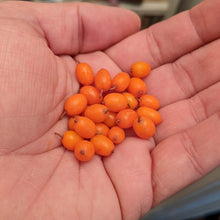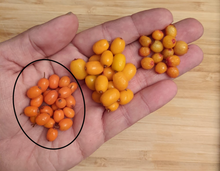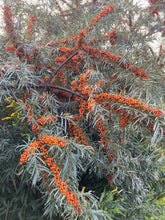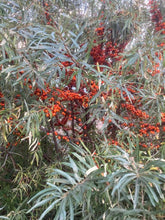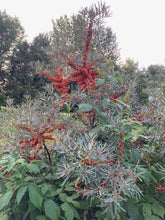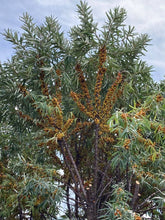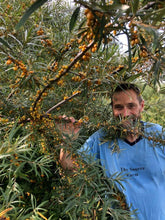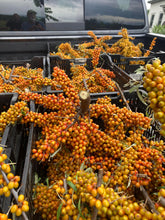Moldovan Sea Buckthorn
Regular price
$5.00
Sale
Hippophae rhamnoides
Origin: Moldova
Improvement status: Unknown
Seeds per packet: ~15
BOTANICAL SAMPLE - NOT GERMINATION TESTED
Life cycle: Perennial
If you've never heard of "sea buckthorn" before (or "seaberry"), well, it might just be the most useful plant you've never heard of. The berries, juice, and oil are incredibly nutritious foods, and all of those plus the leaves and bark have a long history of medicinal and cosmetic use as well. It's also a rare non-leguminous nitrogen-fixer (in symbiosis with Frankia bacteria), and it develops extensive root systems, so it has long been used as a windbreak plant and for erosion control, particularly in cold and blustery places like the western Canadian prairie. The plant is cold-hardy down to -45 degrees (F) and can withstand high temperatures as well, up to 104 degrees (F), making it potentially a very important plant for humanity as the planet continues heating and extreme weather becomes the norm. With its bright orange berries, produced in profusion, and attractive leaves that resemble a cross between willow and olive, it is also highly ornamental and is often planted for that purpose alone. Those pretty leaves are air-dried, then ground up and used to make a tasty and medicinal tea.
Native across northern and central Eurasia, from Britain to Siberia, sea buckthorn is not a true buckthorn (which is a dirty word for many due to the invasiveness of certain species across various North American landscapes), but rather is in the Elaeagnaceae family. The Latin species name "rhamnoides" means "resembles buckthorn", while the genus name "Hippophae" means "shining horse," apparently from an ancient Greek practice of feeding the leaves to horses to improve the sheen of their hair. It grows like a shrub or small tree, and there are multiple subspecies and closely related species. Most individual plants are dioecious, so both pollen-producing ("male") plants and fruit-producing ("female") plants must be present for good fruit production, though occasional self-pollinating plants are not unheard of (Nate believes he found one such plant in the Netherlands and is nursing young seedlings from this plant at his farm in central New York). Experts recommend large plantings have between 6-12% pollen-producing plants, even spaced throughout the orchard, for maximal fruit production.
Seaberries, as they're often called, have a unique and unforgettable flavor, most easily compared with kumquat and passionfruit, sometimes with some distinct pineapple vibes. The high oil content not only in the seeds but in the fruit pulp gives them an unmistakable funkiness that is a turn-off for some. When we offer juice or syrup to people who've never tried it before, we recommend they not smell it first, since the smell is often funkier than the flavor. The juice has a creamy texture that is also unusual for a fruit juice. But despite these quirks, many people absolutely adore sea buckthorn. It makes excellent jams, jellies, and syrups, all of which take very well to mixing with yogurt or ice cream. A winery in Slovakia makes a wine with seaberries (at 11% alcohol). The fruit pulp can also be made into fruit leather or pressed for a delightfully sour juice (improved greatly by sweetening). Leftovers make good livestock feed. The color of the fruit can range from pale yellow to orange-so-deep-it's-almost-red (like the fruit from Moldova that yielded these seeds). The berries contain high levels of Vitamin B12, Vitamin C, Vitamin E, Vitamin K, potassium, manganese, copper, and various polyphenols, phytosterols, carotenoids (like beta-carotene, zeaxanthin, and lycopene), flavonoids, phenolic acids, aminos, and other beneficial fatty acids. It is one of the richest natural sources of Vitamin C in the world.
There's so much more to say about these amazing plants, but this would quickly run to book length. (In fact, there was a foundational English-language text about sea-buckthorn, from propagation to processing to nutrition, borrowing heavily from Chinese, Russian, and other European sources, published by the National Research Council of Canada in 2003, by Thomas Li and Thomas Beveridge. Unfortunately, it was a very limited run, so the book is really hard to come by — as of December 30, 2022, two copies were available for sale online, one for $410 and the other for almost $2,400, strongly hinting at the sort of investments people are making in the sea buckthorn industry right now. Even eBooks on sea buckthorn are running up to $300.)
These seeds come from fresh frozen sea buckthorn fruit imported by Eastern European grocers in Northeast Philadelphia. Of the three varieties found for sale in early winter 2022 (all dated as harvested and frozen in 2022), this one was the darkest in color and had the best flavor eaten out of hand. This batch was grown in Moldova, the small post-Soviet nation sandwiched between Romania and Ukraine (and incidentally where Nate's grandmother Gert was likely born, just across the Prut River from Romania). We don't know if these came from a named cultivar, or which subspecies they represent, but we can surmise that they are highly productive plants since they're being grown on a large enough commercial scale to warrant glossy packaging and export across an ocean.
We're really excited to have Moldovan, Russian, and Latvian sea buckthorn seeds available this year, and we're hopeful that this diversity and the breeding work it supports will further the expansion of sea buckthorn cultivation and use in this country and beyond.
NOTE: Most of these photos come from our friend Buzz Ferver and they show a variety of sea buckthorns. Only the first two photos show the fruit that yielded these seeds.
GERMINATION AND GROWING NOTES: Seeds require pre-treatment for successful germination. Cold-stratify for 90 days by placing seeds in mildly damp sand or other growing medium in a cold refrigerator. After stratification, soak seeds for 48 hours before planting. Some heat (78-84 degrees Fahrenheit) makes them sprout more quickly and uniformly. Alternatively, in climates with cold winters, seeds can be direct-sown into their final location in the fall so they can stratify in place. Young seedlings should be protected from weed pressure and kept relatively moist, though broadly speaking this is a drought-tolerant plant (it can also tolerate mild soil salinity, up to a point). The plants can handle a variety of settings, described in detail below, but they won't really thrive unless they get a lot of sun. Large plantings should be arranged north to south to maximize sunlight on each plant. Growing from seed will likely necessitate some culling of pollen-producing plants for maximal fruit production (because they should come out 50/50). Superior seedlings can be re-propagated very easily through softwood cuttings.
Here's what Li and Beveridge say about where to plant sea buckthorn: "In its natural habitat, sea buckthorn is found on slopes, riverbanks, and seashores in a wide range of soil texture (Li and Schroeder 1996). The plant is adapted to a wide variety of soils and it will grow on marginal land, including sandy, gravelly soils with poor nutrient and water retention. On these sites, supplementary fertilization, particularly phosphorus at planting time, and irrigation once the shrubs are fruiting may be required. Orchards located on fertile soils rarely require fertilization [due to the nitrogen-fixing power of their relationship with bacteria]. Sea buckthorn thrives on well-drained light to medium sandy loam. Clay and heavy loam without organic improvements are not suitable. Light sandy soil has low moisture retention capactiy and may be improved by the addition of organic matter, manure or various composts. Sea buckthorn will not grow well, perhaps not at all, on compacted wetlands or soils subject to long periods of flooding. Water table depth in the growing area should be greater than 1 meter... Sea buckthorn lives in symbiosis with [nitrogen-fixing bacteria] which have low tolerance for acid soil, and prefer a soil pH 5.4-7.0 (Wolf and Wegert 1993). Sea buckthorn prefers soil of pH 6-8. In China, plants have been found in soils ranging from pH 5.5-8.3, although Lu (1992) reported that sea buckthorn thrives best at pH 6-7. Sea buckthorn has moderate tolerance to saline soils. A general rule of thumb is that if the site is saline but grows an acceptable crop of barley, sea buckthorn will grow as well, however, its growth and fruit yield will be reduced. Ideally, soil salinity levels should be less than 1.5 mS/cm."









